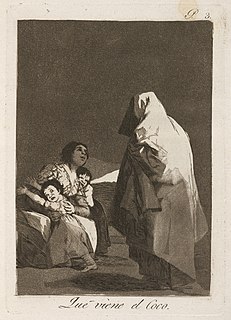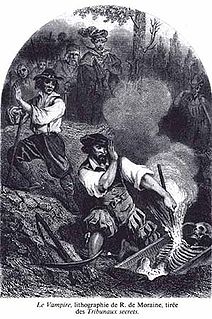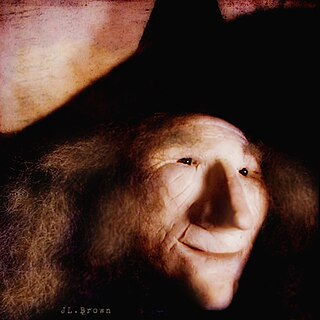This article is missing information about the history of the subject.(May 2012) |
A Boo Hag is a mythical creature in the folklore of Gullah culture. It is a regionalized version of the Hag myth.
This article is missing information about the history of the subject.(May 2012) |
A Boo Hag is a mythical creature in the folklore of Gullah culture. It is a regionalized version of the Hag myth.
According to the legend, Boo Hags are similar to vampires. Unlike vampires, they gain sustenance from a person's breath, as opposed to their blood, by riding their victims. [1] [2] [3]
They have no skin, and thus are red. In order to be less conspicuous, they will steal a victim's skin and use it for as long as it holds out, wearing it as one might wear clothing. They will remove and hide this skin before going riding.
When a hag determines a victim is suitable for riding, the hag will generally gain access to the home through a small crack, crevice, or hole. The hag will then position themselves over the sleeping victim, sucking their breath. This act renders the victim helpless, and induces a deep dream-filled sleep. The hag tends to leave the victim alive, so as to use them again for their energy. However, if the victim struggles, the hag may take their skin, leaving the victim to suffer. After taking the victim's energy, the hag flies off, as they must be in their skin by dawn or be forever trapped without skin. When the victim awakes, they may feel short of breath, but generally the victim only feels tired.
An expression sometimes used in South Carolina is "don't let de hag ride ya." This expression may come from the Boo Hag legend. [4]
While the Boo Hag is a product of Gullah culture, the legend has managed to become known on a wider scale. The legend has been used as an object lesson in stranger danger. [5] [6] The legend has also been the subject of song, [7] and poetry. [8]
In 2005, the Boo Hag became a character in a children's book called Precious and the Boo Hag written by Patricia C. McKissack and Onawumi Jean Moss. In the story, the Boo Hag is said to be strange, tricky, and will do anything to get into the house. Precious, the main character, is told by her brother that the Boo Hag also, "...tries to make you disobey yo' mama!" [9]

A vampire is a creature from folklore that subsists by feeding on the vital essence of the living. In European folklore, vampires are undead creatures that often visited loved ones and caused mischief or deaths in the neighborhoods they inhabited while they were alive. They wore shrouds and were often described as bloated and of ruddy or dark countenance, markedly different from today's gaunt, pale vampire which dates from the early 19th century.
A jiangshi, also known as a Chinese hopping vampire or hopping zombie, is a type of reanimated corpse in Chinese legends and folklore. The characters for "jiangshi" are read geung-si in Cantonese, cương thi in Vietnamese, gangsi in Korean, and kyonshī in Japanese. It is also known as phi dip chin in Thai, hantu pocong in Malay, and vampir cina in Indonesia. It is typically depicted as a stiff corpse dressed in official garments from the Qing Dynasty, and it moves around by hopping with its arms outstretched. It kills living creatures to absorb their qi, or "life force", usually at night, while during the day, it rests in a coffin or hides in dark places such as caves. Jiangshi legends have inspired a genre of jiangshi films and literature in Hong Kong and East Asia.

Sleep paralysis is a state, during waking up or falling asleep, in which a person is aware but unable to move or speak. During an episode, one may hallucinate, which often results in fear. Episodes generally last less than a couple of minutes. It may occur as a single episode or be recurrent.

The Bogeyman is a type of mythical creature used by adults to frighten children into good behavior. The Bogeyman has no specific appearance, and conceptions vary drastically by household and culture, but is most commonly depicted as a masculine or androgynous monster that punishes children for misbehavior. The Bogeyman or a somewhat related creature can be found in every culture. Bogeymen may target a specific act or general misbehaviour, depending on what purpose needs serving, often based on a warning from the child's authority figure. The term "Bogeyman" is sometimes used as a non-specific personification or metonym for terror, and in some cases, the Devil.
The pontianak is a malicious, flesh-eating female ghost in Indonesian folklore. Other common names include "matianak" and "kuntilanak". The figure resembles that of the spirit of a woman who died during pregnancy. This is despite the fact that the earliest recordings of pontianaks in Malay lore describe the ghost as originating from a stillborn child.

The manananggal, which translates to "one who removes/takes off/separates ", is a vampire-like mythical creature native to the Philippines, a malevolent, man-eating and blood-sucking monster or witch.

Yuki-onna is a spirit or yōkai in Japanese folklore that is often depicted in Japanese literature, films, or animation.

A hellhound is a supernatural dog in folklore. A wide variety of ominous or hellish supernatural dogs occur in mythologies around the world. Features that have been attributed to hellhounds include mangled black fur, glowing red eyes, super strength and speed, ghostly or phantom characteristics, and a foul odor. Certain European legends state that if someone stares into a hellhound's eyes three times or more, that person will surely die. In cultures that associate the afterlife with fire, hellhounds may have fire-based abilities and appearance. They are often assigned to guard the entrances to the world of the dead, such as graveyards and burial grounds, or undertake other duties related to the afterlife or the supernatural, such as hunting lost souls or guarding a supernatural treasure. In European legends, seeing a hellhound or hearing it howl may be an omen or even a cause of death. They are said to be the protectors of the supernatural, guarding the secrecy of supernatural creatures, or beings, from the world.

An Alp is a supernatural being in German folklore.

Patricia C. "Pat" McKissack was a prolific African American children's writer. She was the author of over 100 books, including Dear America books A Picture of Freedom: The Diary of Clotee, a Slave Girl;Color Me Dark: The Diary of Nellie Lee Love, The Great Migration North; and Look to the Hills: The Diary of Lozette Moreau, a French Slave Girl. She also wrote a novel for The Royal Diaries series: Nzingha: Warrior Queen of Matamba. Notable standalone works include Flossie & the Fox (1986), The Dark-Thirty: Southern Tales of the Supernatural (1992), and Sojourner Truth: Ain't I a Woman? (1992). What is Given from the Heart was published posthumously in 2019.
The soucouyant or soucriant in Dominica, St. Lucian, Trinidadian, Guadeloupean folklore in Haiti, Louisiana, Grenada and elsewhere in the Caribbean or Ole-Higue in Guyana and Jamaica or Asema in Suriname), in The Bahamas it is known as Hag. It is a kind of blood-sucking hag.
Mythic humanoids are mythological creatures that are part human, or that resemble humans through appearance or character.

The Richmond Vampire is a recent urban legend from Richmond, Virginia.

Legends of vampires have existed for millennia; cultures such as the Mesopotamians, Hebrews, ancient Greeks, and Romans had tales of demonic entities and blood-drinking spirits which are considered precursors to modern vampires. Despite the occurrence of vampire-like creatures in these ancient civilizations, the folklore for the entity we know today as the vampire originates almost exclusively from early 18th-century Southeastern Europe, particularly Transylvania as verbal traditions of many ethnic groups of the region were recorded and published. In most cases, vampires are revenants of evil beings, suicide victims, or witches, but can also be created by a malevolent spirit possessing a corpse or a living person being bitten by a vampire themselves. Belief in such legends became so rife that in some areas it caused mass hysteria and even public executions of people believed to be vampires.

A hag is a wizened old woman, or a kind of fairy or goddess having the appearance of such a woman, often found in folklore and children's tales such as "Hansel and Gretel". Hags are often seen as malevolent, but may also be one of the chosen forms of shapeshifting deities, such as The Morrígan or Badb, who are seen as neither wholly benevolent nor malevolent.
Chedipe is a witch-vampire in the folklore of the region around the Godavari River in India. They are associated with the devadasis, girls who were dedicated to a Hindu temple god and were often treated as temple prostitutes. Women who die an unnatural death, such as in childbirth or by suicide, and prostitutes may become chedipes. Chedipes are sometimes characterized as being undead.

The night hag or old hag is the name given to a supernatural creature, commonly associated with the phenomenon of sleep paralysis. It is a phenomenon during which a person feels a presence of a supernatural malevolent being which immobilizes the person as if sitting on their chest or the foot of their bed. The word "night-mare" or "nightmare" was used to describe this phenomenon before the word received its modern, more general meaning. Various cultures have various names for this phenomenon and/or supernatural character.

Haint blue is a collection of pale shades of blue-green that are traditionally used to paint porch ceilings in the southern United States.
Now remember, don't let nothing and nobody in this house—not even me, 'cause I got a key.